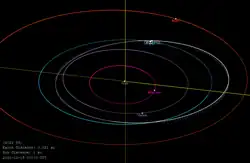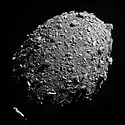 Orbit of 2022 YG | |
| Discovery[1][2] | |
|---|---|
| Discovered by | G. Borisov |
| Discovery site | MARGO Obs. |
| Discovery date | 15 December 2022 |
| Designations | |
| 2022 YG | |
| NEO · Apollo | |
| Orbital characteristics[3] | |
| Epoch 25 February 2023 (JD 2460000.5) | |
| Uncertainty parameter 6 | |
| Observation arc | 4 days[1] |
| Aphelion | 1.197 AU |
| Perihelion | 0.806 AU |
| 1.001 AU | |
| Eccentricity | 0.1953 |
| 1.00 yr (365.91 days) | |
| 349.535° | |
| 0° 34m 16.171s / day | |
| Inclination | 2.348° |
| 274.096° | |
| 271.648° | |
| Earth MOID | 0.003272 AU (489,500 km; 1.273 LD) |
| Physical characteristics | |
| 26.58[3] · 26.64[1] | |
2022 YG is a near-Earth asteroid and a potential quasi-satellite of Earth, discovered by amateur astronomer Gennadiy Borisov at Nauchnyi, Crimea on 15 December 2022. It has an estimated diameter of 16–30 meters, given H of 26.6, and an albedo 4-15%.[lower-alpha 1]
Notes
References
- 1 2 3 "2022 YG". Minor Planet Center. Retrieved 20 December 2022.
- ↑ "MPEC 2022-Y25 : 2022 YG". Minor Planet Electronic Circular. Minor Planet Center. 17 December 2022. Retrieved 20 December 2022.
- 1 2 "JPL Small-Body Database Browser: (2022 YG)" (2022-12-19 last obs.). Jet Propulsion Laboratory. Retrieved 20 December 2022.
External links
- New Quasi-satellite 2022 YG – Animation of 2022 YG's orbit in a rotating reference frame with respect to Earth from 1900–2207, YouTube, 17 December 2022
- 2022 YG at the JPL Small-Body Database
- 2022 YG at ESA–space situational awareness
- 2022 YG at NeoDyS-2, Near Earth Objects—Dynamic Site
This article is issued from Wikipedia. The text is licensed under Creative Commons - Attribution - Sharealike. Additional terms may apply for the media files.

